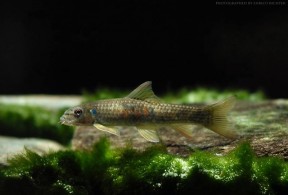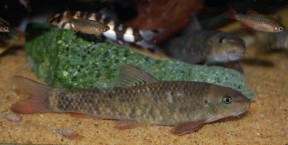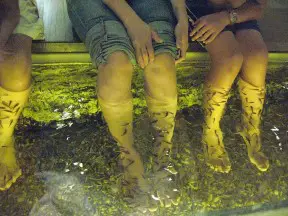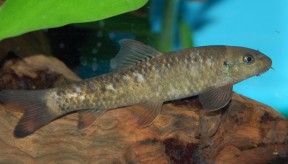Garra rufa
Doctor Fish
SynonymsTop ↑
Discognathus rufus Heckel, 1843; Discognathus obtusus Heckel, 1843; Discognathus crenulatus Heckel, 1847; Garra rufa gymnothorax Berg, 1949
Etymology
Garra: vernacular Gangetic name for a particular species of “sand-digger,” which Francis Buchanan-Hamilton applied as a generic name for bottom-dwelling cyprinids “with no affinity to another genus”.
rufa: from the Latin rufus, meaning ‘red, reddish’, in reference to the reddish pigmentation on the head in some individuals.
Classification
Order: Cypriniformes Family: Cyprinidae
Distribution
Widespread in the eastern Mediterranean and Middle East regions, from the Ceyhan, Seyhan, Asi, and smaller river systems in Turkey, throughout coastal watersheds in Syria, the now mostly-desiccated Qweik River in Turkey and Syria, the Jordan River drainage in Jordan and Israel (except the southern Dead Sea basin where it is replaced by the congener G. ghorensis), and the Tigris-Euphrates system in Turkey, Syria, Iraq, and Iran.
In southwestern Iran it is also present in the Lake Maharlu basin and coastal drainages as far south as the Mond River in Bushehr Province.
Type locality is ‘Aleppo, Syria’.
Habitat
Tends to inhabit swiftly-flowing sections of headwaters and tributaries but also occurs in some larger, lowland river channels, and man-made reservoirs. The most favourable habitats contain clear, oxygen-saturated water which, allied with the sun, facilitates the development of a rich biofilm carpeting submerged surfaces.
In some cases it inhabits ephemeral habitats which become partially desiccated during certain times of year.
Maximum Standard Length
100 – 120 mm.
Aquarium SizeTop ↑
An aquarium with base measurements of 120 ∗ 45 cm should be the minimum size considered.
Maintenance
Not difficult to keep in a well-maintained set-up, but a display arranged to resemble a flowing stream or river, with a substrate of variably-sized, water-worn rocks, sand, fine gravel and perhaps some small boulders, is highly recommended. This can be further furnished with driftwood roots or branches, and hardy aquatic plants.
Most importantly, the water must be clean and well-oxygenated with turnover preferably in excess of 10 times per hour; additional powerheads and airstones can be employed to achieve the desired flow and oxygenation if necessary. Bright lighting will promote development of biofilm on solid surfaces, upon which the fish will graze.
Since it needs stable water conditions and grazes biofilm this species should never be added to a biologically immature set-up, and a tightly-fitting cover is necessary since it can literally climb glass.
Water Conditions
Temperature: 14 – 20 °C; strictly not a tropical species and in most cases an additional heater will not be required.
pH: 6.0 – 8.0
Hardness: 18 – 268 ppm
Diet
Although it will graze algae if available this species is not an exclusive herbivore. Offer meaty foods such as live or frozen chironomid larvae (bloodworm), Tubifex, Artemia, chopped prawn, etc., along with good quality, sinking dried products, at least some of which should contain a significant proportion of vegetable matter such as Spirulina or similar.
Fresh fruit and vegetables such as cucumber, melon, blanched spinach or courgette can be offered occasionally and home-made, gelatine-bound recipes containing a mixture of dried fish food, puréed shellfish, fresh fruit and vegetables, are also proven to work well.
Behaviour and CompatibilityTop ↑
Relatively peaceful and can be maintained alongside other species which require similar environmental conditions.
It isn’t particularly tolerant of conspecifics in small aquaria, but exists in loose aggregations in the wild. If kept singly it tends to behave more aggressively with similarly-shaped fishes so we recommend the purchase of 3-4 or more should space permit. Such a group will develop a noticeable pecking order between themselves, but tankmates are more likely to be left alone.
Sexual Dimorphism
Sexually mature females are noticeably thicker-bodied than males, while large males develop extensive tuberculated patches on the head and snout..
Reproduction
Large numbers of fish traded as Garra rufa are produced in several countries, but it is unclear exactly which populations, and therefore species, are involved (see ‘Notes’). It is also uncertain if these are bred naturally or via artificial stimulation with hormones.
Wild populations tend to spawn continuously over a prolonged period, typically between April and November. Eggs are scattered over gravel or rocks and the adults do not exhibit parental care.
NotesTop ↑
Fish referred to as G. rufa are marketed worldwide as ‘doctor fish’, with the questionable ability to remove dead and scaly skin and ease complaints such as psoriasis. These fish are quite commonly available in the aquarium trade as well, although in both cases it is unclear whether they represent G. rufa or another, related species.
This is because the current view of G. rufa is likely to represent a complex of closely-related taxa rather than a single species (J. Freyhof, pers. comm.). The type locality is in Syria, whereas the commerical fish originate largely from Israel and possibly Turkey. Different populations, sometimes within the same country, tend to vary in appearance, and the possibility of hybridisation cannot be ruled out either.
That said, the fish do display some similarities across large portions of their range. Following Coad (2010) populations of G. rufa from Iraq and Iran can be diagnosed as follows: two pairs of barbels; modally 8 (87.1% for 534 fish, range 6-8) branched dorsal-fin rays; adhesive disc on lower head surface well-developed with free anterior margin.
While body and fin colouration are highly variable, most populations possess a dark or iridescent blue spot at the upper extremity of the opercle and another on the caudal peduncle which tends to be more prominent in young individuals. There are usually a series of dark markings present at the base of the central dorsal-fin rays and in many cases the tip of the upper caudal-fin lobe is black.
The genus Garra is a particularly enigmatic grouping with new taxa described on a regular basis, while many of the existing ones may represent cases of misidentification or synonyms of other species. Some of the revisions have also been called into question, which has added further confusion. A full generic review would be ideal but is unlikely to materialise given the extensive distribution of its members which range from southern China across much of southeast Asia, India and the Middle East as far as north/central Africa.
Instead a number of less-extensive works published in recent years have resulted in a gradual, but continuing, improvement in knowledge, and it remains possible that the genus will be broken up into smaller taxa since the current assemblage is almost certainly polyphyletic.
Garra species are usually included in the subfamily Labeoninae/Cyprininae or tribe Labeonini (name varies with author) which by recent thinking is further divided into four subtribes; Labeoina, Garraina, Osteochilina, and Semilabeoina (Yang et al., 2012). The putatively monophyletic Garraina comprises a number of genetic lineages including Garra sensu stricto (which also includes Horalabiosa, Phreatichthys and possibly other genera), a small clade comprising Garra cambodgiensis and G. fascicauda (thus rendering Garra polyphyletic), Paracrossocheilus, and Gonorhynchus (which includes Akrokolioplax).
Two Garra species, G. imberba and G. micropulvinus, are placed in the Semilabeoina assemblage, and the generic name Ageneiogarra Garman, 1912 has been suggested for them, although this does not appear to have been widely followed (e.g. Kottelat, 2013). In addition, some genera which were previously considered to be close relatives of Garra species such as Discogobio, Discocheilus and Placocheilus, are now also placed in this subtribe.
All genera currently included in Garraina possess a lower lip modified to form a mental adhesive disc, allowing the fish to cling to surfaces in turbulent conditions. In most species the upper lip is almost entirely reduced and both the upper and lower jaw margins are keratinised, i.e., horny, and used to scrape food items from the substrate.
Garra species are distinguished from other Garraina members by the first two pectoral-fin rays usually being thickened, fleshy and unbranched, possession of 10-11 dorsal-fin rays, and a combination of internal characters. Some species have evolved particular environmental specialisms such as highly reduced eyes in hypogean forms or the ability to survive in thermal springs.
References
- Heckel, J. J., 1843 - E. Schweizerbart'sche Verlagshandlung. Stuttgart. v. 1 (pt 2): 990-1099
Ichthyologie [von Syrien]. In: J. von Russegger. Reisen in Europa, Asien und Africa, mit besonderer Rücksicht auf die naturwissenschaftlichen Verhältnisse der betreffenden Länder unternommen in den Jahren 1835 bis 1841, etc. - Abedi, M., A. H. Shiva, H. Mohammadi, and R. Malekpour, 2011 - Turkish Journal of Zoology 35(3): 317-323
Reproductive biology and age determination of Garra rufa Heckel, 1843 (Actinopterygii: Cyprinidae) in central Iran. - Coad, B. W., 1998 - Italian Journal of Zoology 65(S1): 101-108
Systematic biodiversity in the freshwater fishes of Iran. - Coad, B. W., 2010 - Pensoft Series Faunistica #93: 1-294
Freshwater Fishes of Iraq. - Eskmaeili, H. R., B. W. Coad and A. Gholamifard, N. Nazari, A. Teimory, 2010 - Zoosystematica Rossica 19(2): 361-386
Annotated checklist of the freshwater fishes of Iran. - Goren, M., 1974 - Israel Journal of Zoology 23(2): 67-118
The freshwater fishes of Israel. - Hamidan, N., 2004 - Landesmuseen Neue Serie 2: 385-394
The freshwater fish fauna of Jordan. - Stiassny, M. L. J. and A. Getahun, 2007 - Zoological Journal of the Linnean Society 150(1): 41-83
An overview of labeonin relationships and the phylogenetic placement of the Afro-Asian genus Garra Hamilton, 1922 (Teleostei: Cyprinidae), with the description of five new species of Garra from Ethiopia, and a key to all African species. - Yang, L., M. Arunachalam, T. Sado, B. A. Levin, A. S. Golubtsov, J. Freyhof, J. P. Friel, W-J. Chen, M. V. Hirt, R. Manickam, M. K. Agnew, A. M. Simons, K. Saitoh, M. Miya, R. L. Mayden, and S. He, 2012 - Molecular Phylogenetics and Evolution 65(2): 362-379
Molecular phylogeny of the cyprinid tribe Labeonini (Teleostei: Cypriniformes). - Zhang, E., 2005 - Zoological Studies 44(1): 130-143
Phylogenetic relationships of labeonine cyprinids of the disc-bearing group (Pisces: Teleostei).





